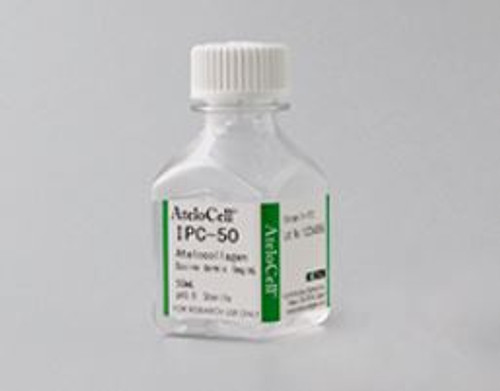Atelocollagen, Bovine dermis, 5mg/mL
Cosmo Bio
- SKU:
- KOU-IPC-50
- Shipping:
- Calculated at Checkout
These products are prepared with highly purified type I collagen derived from bovine dermis. Neutral Solution products are pH neutral, come premixed in several commonly used culture media, and gelate at 37°C. In contrast to cell-derived soluble basement membrane preparations, Collagen Solutions are free from bioactive substances, nucreic acids, MMP, etc. allowing experimental results to be evaluated more clearly.
Applications
- Collagen coating for cell cultureware
- Cell culture in a collagen gel
- Cell culture on a collagen gel
Features
- Native collagen gelates when neutralized and placed under physiological condition.
- Ready-to-use: atelocollagen is premixed with medium
This product is manufactured in Japan and produced from raw materials obtained from livestock certified born and raised in Australia or New Zealand. Japan, Australia and New Zealand are all recognized by the World Health Organization as having negligible risk for Bovine Spongiform Encephalitis (BSE). Nevertheless, please consult with your country's Customs office to confirm importability.
References
1. Arai KY, et al. Stimulatory eff ect of fi broblast-derived prostaglandin E2 on keratinocyte stratifi cation in the skin equivalent. (2014) Wound Repair
Regin. 22(6): 701-711
2. Sakakibara A, et al. Dynamics of centrosome translocation and microtubule organization in neocortical neurons during distinct modes of
polaristion. (2014) Cereb Cortex. 24(5): 1301-1310.
3. Uekita T, et al. Oncogenic Res/ERK signaling activates CDCP1 to promote tumor invasion and metastasis. (2014) Mol Cancer Res.12(10): 1449-
1459.
4. Yonemura S. Diff erential sensitivity of epithelial cells to extracellular matrix in polarity setabilishment. (2014) PLoS One. 9(11): e112922.
5. Correia AL, et al. The hemopexin domain of MMP3 is responsible for mammary epithelial invasion and morphogenesis through extracellular
interaction with HSP90 β . (2013) Genes Dev. 27(7): 805-817.
6. Eguchi R, et al. FK506 induces endothelial dysfunction through attenuation of Akt and ERK1/2 independently of calcineurin inhibition and the
caspase pathway. (2013) Cell Signal. 25(9): 1731-1738.
| Documents & Links for Atelocollagen, Bovine dermis, 5mg/mL | |
| Datasheet | Atelocollagen, Bovine dermis, 5mg/mL Datasheet |
| Flyer | Atelocollagen, Bovine dermis, 5mg/mL Flyer |
| Vendor Page | Atelocollagen, Bovine dermis, 5mg/mL at Cosmo Bio |
| Documents & Links for Atelocollagen, Bovine dermis, 5mg/mL | |
| Datasheet | Atelocollagen, Bovine dermis, 5mg/mL Datasheet |
| Flyer | Atelocollagen, Bovine dermis, 5mg/mL Flyer |
| Vendor Page | Atelocollagen, Bovine dermis, 5mg/mL |









